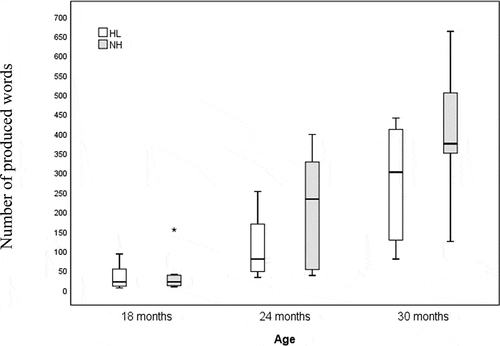Figures & data
Table 1. Descriptive data of the children with HL. Unaided four-frequency (4 F) pure-tone average (PTA): (500, 1000, 2000 and 4000 Hz), mean dB HL over time measured at 10, 18, 24 and 30 months; age at amplification; hours of hearing aid (HA) is from datalogging of the HAs at each of the ages. Aided audibility is presented as Speech Intelligibility Index (SII values). Auditory development is from results on the LittlEARS Auditory Questionnaire®/LEAQ and scores of functional auditory performance in noise with Parent´s Evaluation of Aural/Oral Performance in Children /PEACH.
Table 2. The complexity parameters in the Swedish version of the Word Complexity Measure (WCM-SE) (Marklund et al., Citation2018a) and the points given for each parameter.
Table 3. Swedish version of Word Complexity Measure (WCM-SE) calculations of five SECDI-II words with complexity sum ranging from 0 to 8. Columns represent Swedish word, phonetic transcription according to CitationIPA, English translation of the word, points given to occurring WCM-SE complexity parameters, and complexity sum for each word.
Table 4. Descriptive statistics for each participant in the group of children with normal hearing (NH) and children with hearing loss (HL), on number of different true consonants at 18 months, number of words produced based on parent reports (SECDI-II) and (in brackets) mean complexity sum of the words reported at 18, 24 and 30 months.
Figure 1. Number of produced words on the SECDI-II for children with HL and NH at ages 18, 24 and 30 months (n = 8) in both groups at all ages.

Figure 2. Estimated marginals mean number of produced words on the SECDI-II. The dotted line represents the children with HL, the dashed line the children with NH and the solid line is a group of 420 children used as a reference for Swedish children with NH (boys only to match the study participants) from the Wordbank. The children with HL and NH were (n = 8) at all ages.

Table 5. Spearman rank correlations (rho) between the total number of different true consonants at 18 months to number of words produced on the SECDI-II at 18, 24 and 30 months. Results are presented for the whole group and each group: children with HL (n = 8) and children with NH (n = 8).
Table 6. Spearman rank correlations (rho) between auditory variables and total number of words produced on the SECDI-II at 18, 24 and 30 months in the children with hearing loss.
